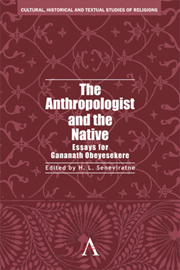Book contents
- Frontmatter
- Contents
- Editor's Note
- The Anthropologist and the Native: Essays for Gananath Obeyesekere
- SECTION I THE INDIAN TRADITION AND ITS REPRESENTATION
- SECTION II CASTE, KINSHIP, LAND AND COMMUNITY
- SECTION III RENUNCIATION AND POWER
- The Morality of Refusal
- Revolt in the Temple: Politics of a Temple Paintings Project in Sri Lanka
- Pain and Power: Reflections on Ascetic Agency
- SECTION IV BUDDHISM TRANSFORMED
- SECTION V THE ENIGMA OF THE TEXT
- SECTION VI THE ANTHROPOLOGIST AND THE NATIVE
- List of Contributors
Revolt in the Temple: Politics of a Temple Paintings Project in Sri Lanka
from SECTION III - RENUNCIATION AND POWER
Published online by Cambridge University Press: 05 May 2012
- Frontmatter
- Contents
- Editor's Note
- The Anthropologist and the Native: Essays for Gananath Obeyesekere
- SECTION I THE INDIAN TRADITION AND ITS REPRESENTATION
- SECTION II CASTE, KINSHIP, LAND AND COMMUNITY
- SECTION III RENUNCIATION AND POWER
- The Morality of Refusal
- Revolt in the Temple: Politics of a Temple Paintings Project in Sri Lanka
- Pain and Power: Reflections on Ascetic Agency
- SECTION IV BUDDHISM TRANSFORMED
- SECTION V THE ENIGMA OF THE TEXT
- SECTION VI THE ANTHROPOLOGIST AND THE NATIVE
- List of Contributors
Summary
This paper is about a project by a Dutch artist to paint murals at a Buddhist temple, the Ginivalla Navamunisaya temple, in southern Sri Lanka. Supported by her father Eddy Roos, and assisted (in colour mixing) by a third Dutch national Rachell Daniell, Noella was near the completion of her project when, under the cover of darkness, a mob invaded the temple and vandalised the murals. What is the meaning of this ungracious act? My task in this paper is to find an answer to this question.
Built in 1825, the temple that is the focus of our attention is best known as the Kataluva temple, after the name of the small town in which it is located. By 2002 Noella Roos had been living in Sri Lanka for five years, and had visited the temple several times. Some parts of the temple had been recently restored with the outer walls of the image house still remaining unpainted. Noella Roos expressed to the chief monk Migoda Kalyanatissa her interest in doing a series of paintings, depicting Buddhist themes, on the blank walls. The project had however been assigned to Walter Kulasuriya, an artist from the nearby town Ahangama, and he had already started work at the time Noella Roos made her request in February 2002. The chief monk, an educated man with an innovative bent of mind, seems to have been impressed enough by Noella Roos' interest to ponder the question and make inquiries about her credentials.
- Type
- Chapter
- Information
- The Anthropologist and the NativeEssays for Gananath Obeyesekere, pp. 179 - 202Publisher: Anthem PressPrint publication year: 2011



